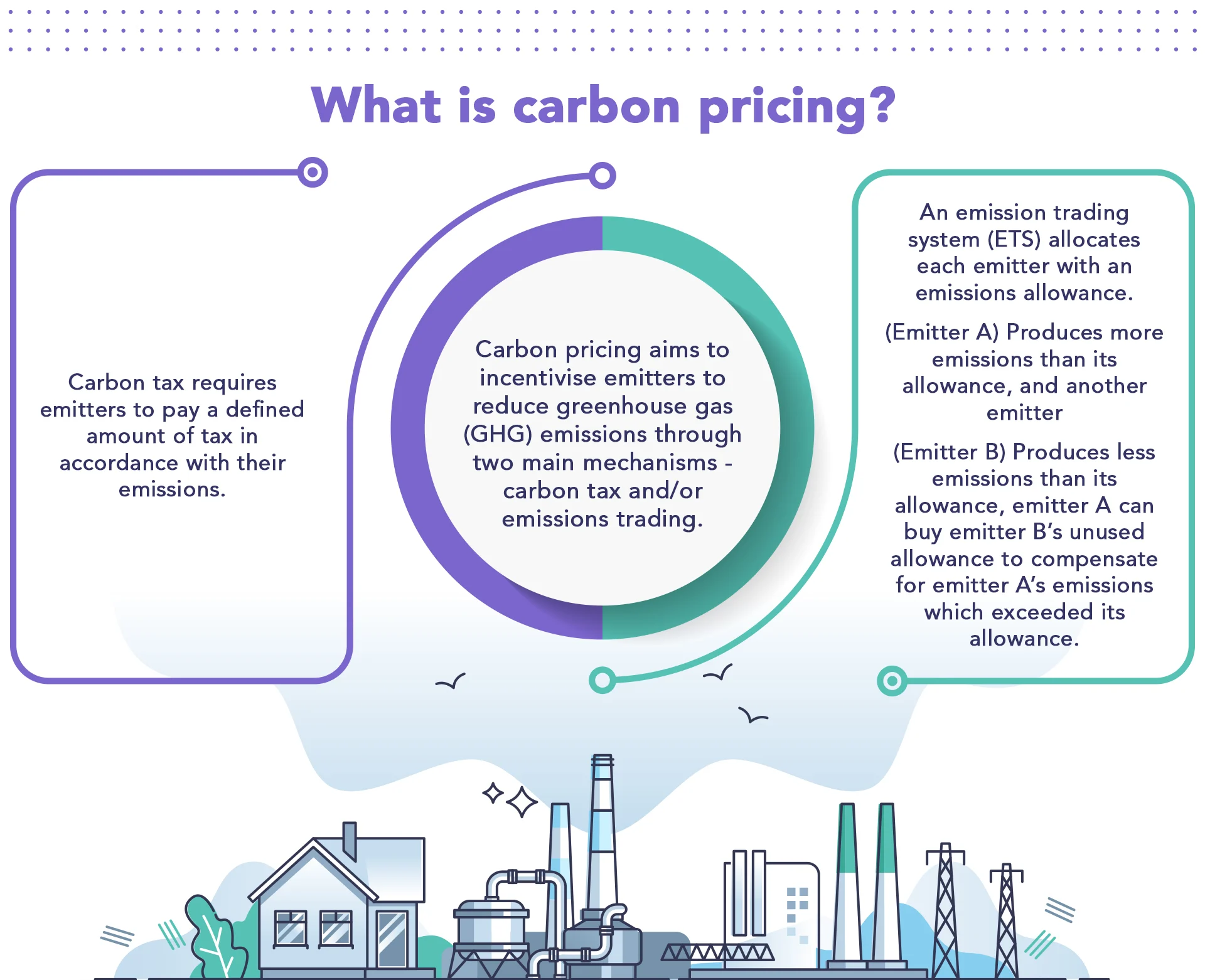India’s Carbon Pricing Strategy: Balancing Growth and Sustainability.
India’s Carbon Pricing Strategy:
This essay looks at the article “We must Take a Pragmatic Approach to Carbon Pricing” by Prachi Priya & R.V. Anuradha, published in The Mint on October 17, 2024. It explains India’s plan for reducing greenhouse gas emissions while still focusing on growing its economy. India’s approach shows that the country is serious about climate action but also understands the need to balance this with its energy needs and growing industries.
Climate change is a pressing global issue, and many countries are adopting carbon pricing strategies to curb greenhouse gas emissions. Carbon pricing is a method that places a financial cost on carbon emissions, encouraging industries and individuals to reduce their carbon footprint.
While many developed nations have implemented strict carbon pricing mechanisms, developing countries like India face the challenge of balancing their climate goals with economic development needs. This analysis supports India’s approach to carbon pricing, which wisely balances reducing greenhouse gas emissions and growing the economy. It considers India’s special situation as a developing country with big energy needs and plans for industrial growth.

India’s Carbon Pricing Mechanisms
India has not implemented a formal carbon price like many European nations, but it has introduced several mechanisms that serve the same purpose. These strategies aim to control carbon emissions while ensuring that India’s growth is not compromised. Let us have a look at some of these mechanisms.
Perform, Achieve, and Trade (PAT) Scheme
One of the key components of India’s carbon pricing efforts is the Perform, Achieve, and Trade (PAT) scheme. Introduced in 2012, the PAT scheme targets energy-intensive industries and aims to improve energy efficiency. Industries such as steel, cement, and thermal power plants must meet specific energy-saving targets. If they exceed these targets, they earn Energy Savings Certificates (ESCerts), which can be traded with companies that fail to meet their targets.
The success of the PAT scheme is evident from its first cycle (2012-2015), where India achieved energy savings equivalent to avoiding about 31 million tonnes of CO2 emissions. This market-based system allows companies to reduce emissions cost-effectively while encouraging energy efficiency in a growing economy.
Renewable Purchase Obligations (RPOs)
India has also implemented Renewable Purchase Obligations (RPOs), which require electricity distribution companies and large energy consumers to purchase a certain percentage of their electricity from renewable sources like solar and wind. This policy promotes the use of cleaner energy and reduces the reliance on fossil fuels.
The RPO mechanism helps India reduce emissions from its rapidly growing power sector, and it complements the country’s goal of increasing the share of renewables in its energy mix. This approach encourages investment in the renewable sector and ensures that India’s energy transition remains on track.
Carbon Credit Trading Scheme (CCTS)
India is in the process of rolling out a Carbon Credit Trading Scheme (CCTS), which is set to start in 2025. This scheme will create a national carbon market where companies can trade carbon credits. Companies that exceed their emission reduction targets can sell their extra credits to companies that fail to meet their goals. This market-based approach ensures that companies can reduce emissions at the lowest possible cost.
The CCTS will play a significant role in India’s carbon pricing strategy, allowing industries to gradually transition to lower carbon emissions while maintaining their competitiveness. The scheme reflects India’s commitment to tackling climate change without imposing drastic costs on its growing industries.
India’s Unique Position on Carbon Pricing
India’s approach to carbon pricing is shaped by its status as a developing country. While it is the world’s third-largest emitter of carbon dioxide, its per capita emissions are still far below the global average. This is important to consider when comparing India’s carbon pricing mechanisms with those of developed countries like the European Union (EU).
Balancing Growth and Climate Action
India’s primary focus is on economic growth and poverty alleviation. As a developing country, it faces the challenge of reducing emissions while ensuring that millions of people have access to energy. Thus, India’s carbon pricing mechanisms are designed to balance economic development with climate action.
Unlike the European Union, where carbon prices are high to push industries to decarbonize, India’s approach is more gradual. For example, carbon prices in the EU can reach as high as 100 euros per tonne of CO2, while in India, the focus is on sector-specific targets and market-based mechanisms that allow flexibility and gradual transition.
Common But Differentiated Responsibilities
India’s carbon pricing strategy also reflects the principle of Common But Differentiated Responsibilities (CBDR-RC), a key element of the Paris Agreement. This principle recognizes that while all countries have a shared responsibility to address climate change, their capabilities differ based on their levels of development. India advocates for this principle in global forums, emphasizing that developing countries like itself should not be held to the same emission reduction standards as developed countries that have historically contributed more to global emissions.
Challenges and Global Comparisons
While India’s approach to carbon pricing is well-suited to its development goals, it faces several challenges. The international community, especially the EU, has implemented mechanisms like the Carbon Border Adjustment Mechanism (CBAM), which places tariffs on carbon-intensive imports from countries that do not have equivalent carbon pricing mechanisms. This policy could hurt Indian exports of products like steel and aluminum, increasing their cost by 20-35%.
India has criticized the CBAM, calling it a trade barrier that disproportionately affects developing countries. India argues that unilateral measures like this do not consider the different stages of development across nations. As a result, India is advocating for a global carbon pricing framework that takes into account the development needs of countries like itself.
Moving Forward: Mitigation Strategies for India
To navigate these challenges and continue its progress on climate action, India has devised several strategies. First, it plans to streamline its carbon pricing mechanisms by rationalizing existing levies on carbon-intensive sectors like coal mining and electricity generation. By consolidating these levies, India can create a more transparent and efficient system that aligns with its climate goals while reducing the administrative burden on industries.
India is also considering implementing a single carbon tax to replace the multiple taxes that currently apply to different sectors. This carbon tax would be phased in gradually to allow industries and consumers to adjust. The revenues from this tax could be used to fund investments in low-carbon infrastructure, such as renewable energy projects and clean transportation.
Additionally, India plans to enhance existing programs like the Perform, Achieve, and Trade (PAT) scheme and the Renewable Purchase Obligations (RPOs) to ensure that they remain effective in reducing emissions. Fast-tracking the implementation of the Carbon Credit Trading Scheme (CCTS) is another priority, as this will allow companies to participate in a robust carbon market and meet their emission reduction targets more efficiently.
Conclusion
India’s pragmatic approach to carbon pricing reflects its unique position as a developing country with growing energy needs and industrial ambitions. Through market-based mechanisms like the PAT scheme and the upcoming CCTS, India is addressing carbon emissions in a way that balances economic growth with climate responsibility. While India’s carbon pricing policies are still evolving, they are already making a significant impact on reducing emissions.
As India continues to refine its approach, it must address challenges posed by international trade policies like the CBAM while ensuring that its industries remain competitive. By streamlining its carbon pricing mechanisms and investing in low-carbon infrastructure, India can lead the way in sustainable development while fulfilling its commitments to the global fight against climate change.
Subscribe to our Youtube Channel for more Valuable Content – TheStudyias
Download the App to Subscribe to our Courses – Thestudyias
The Source’s Authority and Ownership of the Article is Claimed By THE STUDY IAS BY MANIKANT SINGH




